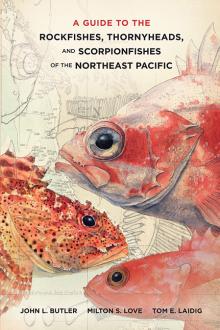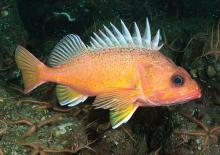
UCSB Research Biologist Publishes Guide to Rockfishes, Shares Expertise in Video


When it comes to rockfish, Milton Love has become a go-to guy. At least once a week, he receives an e-mail message –– complete with digital image –– from someone seeking his expertise in identifying a species of rockfish.
"I just got one the other day from a woman in Seattle," said Love, a research biologist at UC Santa Barbara's Marine Science Institute. "She had been diving off the coast of Oregon, and she sent a picture of a juvenile rockfish, asking if we could tell her what it is." To respond to those requests more easily –– and collectively –– Milton and two of his colleagues have recently published "A Guide to the Rockfishes, Thornyheads, and Scorpionfishes of the Northeast Pacific" (University of California Press, 2012).
Written with John L. Butler, a retired research fishery biologist at the Southwest Fisheries Science Center, and Tom E. Laidig, a research biologist at the National Marine Fisheries Service, the guide is as an encyclopedia of the approximately 84 known species of scorpaenid fishes (rockfishes, thornyheads, and scorpionfishes). The fishes are found predominantly on the Pacific coast of the United States, from Oregon to Baja California. "There are four or five species in the Atlantic, 30 or so off Japan, and a couple in South America," Love said. "But the greatest number of species are found off the coast of California. The implication is that most of the speciation occurred here."
The classic theory of how plants and animals speciate involves some kind of breakdown in communication among the population, Love explained. "Say you've got a river that's full of trout. A landslide occurs that leaves some trout on one side, and some on the other. They can't communicate with each other, and, over time, they develop into different species." With rockfish, however, no obvious barrier separates some from the others, so how the communication breakdown happens is unclear. "It's called sympatric speciation," Love continued. "Species are in contact with one another, but, for some reason, some of them no longer mate with the rest. We don't know why that happens."
According to Love, who is also the author of "Certainly More Than You Wanted to Know About the Fishes of the Pacific Coast," the process continues even now. Pairs of species that are relatively new –– that separated in, say, the last 50,000 years –– will sometimes mate with one another; but it doesn't happen very often. "There are two species that until last year were thought to be the same one," he said. "But now it's known that they are genetically different. And if you look at them very carefully, you can pick out subtle differences. It's endlessly fascinating, and that's the reason people are puzzled all the time."
Hence, the book, which is designed to provide as accurate an answer as possible to the question, "What is that?" The book contains color photos of the fish –– both adult and juvenile –– as well as detailed information about their size and general presentation, geography, habitat, and similar species.
In addition to co-authoring the book, Love has lent his expertise –– as well as his voice and rockfish puppet –– to a short video designed to inform anglers about rockfish and barotrauma. This life-threatening condition occurs when the fish is caught in deep water and brought to the surface so quickly that the gas in its swim bladder expands. "Everything gets pushed aside, and, inevitably, the fish's stomach is shoved out through its mouth," Love explained.
Because some species of rockfish have been overfished throughout the last decade, anglers who catch them are now required to return them to the water. However, if it's not done properly, the fish will die. "The fish are like balloons because of the expanded gas," said Love. "They float on top of the water and get eaten."
Alena Pribyl, a project scientist with the California Ocean Science Trust, conducted research on barotrauma as a doctoral student at the University of Oregon. "She and others found that if you return the fish very quickly to the right depth, much of the time they survive just fine," Love said.
When Pribyl decided to produce a video –– complete with original rap song –– to teach anglers how to release the fish properly, she contacted Love. He helped to write the script, and supplied his Rocky the Rockfish puppet –– plus the hand and voice that bring him to life. "The video came out really, really well," Love said. "My daughter even posted it on her Facebook page."
The video can be found at http://www.youtube.com/watch?v=EiZFghwVOyI.
Related Links



